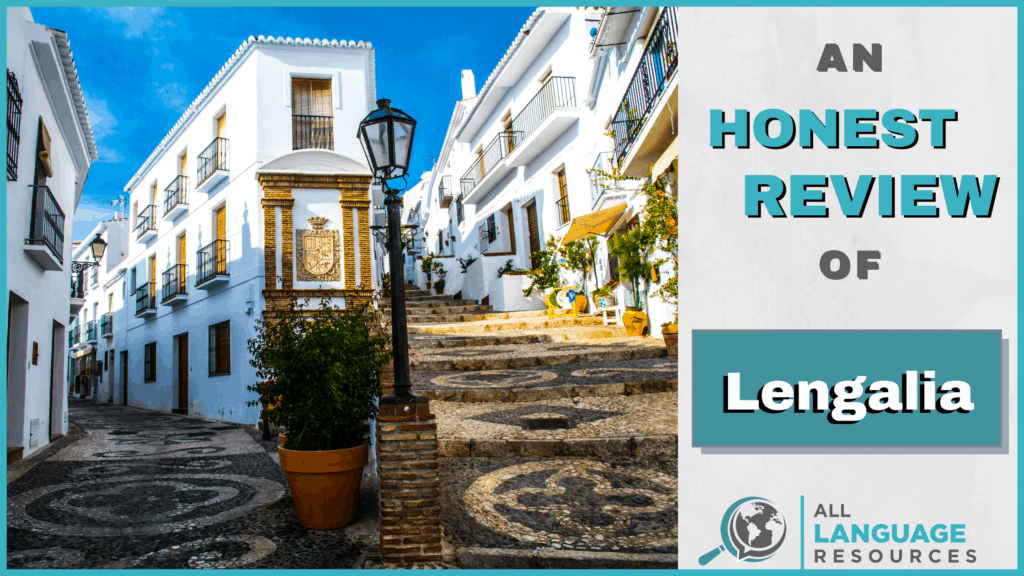Lengalia

Summary
Lengalia is an online resource for learning Spanish. It offers extensive material at all levels and across a wide variety of focuses. There are courses for those learning Spanish for business, for travel, and general Spanish. Lengalia also offers official CEFR certifications for students that complete a course.
There were some mistakes in the material and the interface isn’t very fun to use, but the audio quality and advanced material are good.
While there isn’t much in the way of speaking and writing practice, the lessons are very thorough and well-structured.
The price may be worth it for those interested in obtaining a CEFR certificate, but there are more efficient ways to learn.
I Like
- It has good material for advanced learners.
- The translation tool is very helpful.
- Lessons are structured well.
I Don’t Like
- The practice opportunities can get repetitive.
- There are some mistakes in the material.
- There isn’t much of a communicative aspect.
- The tutor feature is misleading.
Price
A subscription to one course, without videos or podcasts, is $34.99/month. A subscription to all 24 courses, with access to videos and podcasts, is $133.98/year.
Resources that are focused on teaching one language generally do a better job at it than those that set out to teach a bunch of different languages. For this reason, I was excited to try out Lengalia, a Spanish-only resource.
Lengalia is a thorough resource for learning Spanish that’s full of reading material, listening material, and grammar explanations. It’s got courses for learners at all levels in addition to podcasts and business courses.
It’s tailored to the more academic learner that wants to focus on their grammar skills. The practice exercises can get monotonous, and it isn’t the best resource for quickly building your vocabulary, but it does incorporate Youtube videos into the lessons and include some interesting cultural insights to try and make the learning experience more engaging.
Getting Started With Lengalia
Go to the Lengalia website and you’ll quickly be greeted by a flurry of stock photos.

Victorious laptop girl and bearded call-center guy appear in several places throughout the website. Maybe I’m being unfair, but stock photos like these kind of drive me crazy. I’d love to see pictures of people that actually work at Lengalia.
Anyway, further down the home page there’s a description of what makes up the Lengalia experience.

Sounds pretty good! Lengalia is really aiming at being a comprehensive resource for anyone learning Spanish, no matter what their level.
I’ve been studying Spanish on and off for quite a while, so I decide to take the placement test. Let’s see what that’s like.
Finding Your Level With a Placement Test
Lengalia offers a free placement test so prospective users can see their Spanish CEFR level.

This is actually one of the more thorough placement tests I’ve taken, especially for free. It took me upwards of 20 minutes and included fill-in-the-gap questions as well as reading and listening comprehension exercises.
The material got quite intense by the end; the listening activities were about sustainable development efforts in African countries and there were some questions involving less common idioms.
There aren’t any writing or speaking elements to the placement test, and that’s probably because human feedback would be required. Still, the placement test is equipped to test advanced learners, which is something quite a few resources are unable to do effectively.

I got a placed at C1, which is at the high end of what I was expecting. The fact that the test focuses entirely on reading and listening skills probably has something to do with my placement — my receptive skills are certainly more advanced than my productive skills.
Once you receive your level placement, Lengalia recommends courses based on your level. At this point, you’ll need to purchase a subscription or sign up for the 48-hour free trial to get full access.
Alternatively, you can try out one lesson in each course for free on the Lengalia website. This option doesn’t require you to sign up.
Courses
As you can see in the image below, there are quite a few courses on offer at Lengalia. After the free trial, you can either purchase one course for one to three months or you can purchase access to all of the courses for one year.

For this review, I tried out two Spanish grammar courses, A0 and B2, as well as some podcasts.
Each Spanish grammar course has the same general lesson flow. As an example, we’ll look at the first lesson of the B2 intermediate grammar course.
Introduction
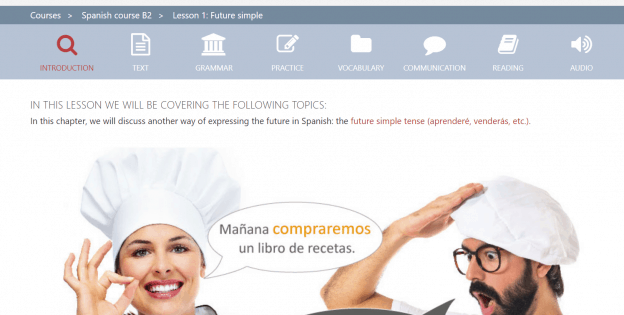
The lesson starts out with an “introduction.” This one’s a cheesy photo and some dialogue using the language you’ll learn in the lesson.
Text
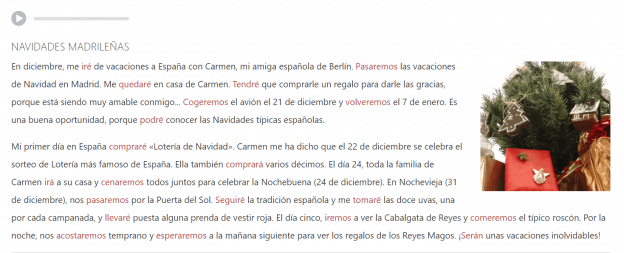
The text at the beginning of the lesson is supposed to introduce the language focus (highlighted in red) in a context. There’s the option to listen to the monologue and read along, which is nice. The audio quality is high.
Next comes some comprehension questions about the reading.
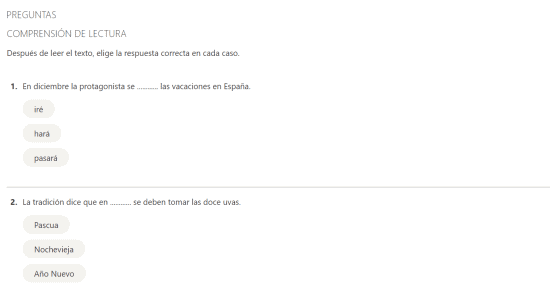
This isn’t a part of every lesson. An introductory text would be too much for the more basic lessons and so you won’t see it at the beginner level.
Grammar
After you’ve been introduced to the language point and seen it in an example text, Lengalia provides a detailed explanation of what’s going on. In this case, it’s the future simple tense.

These descriptions are mostly really good and detailed. Unfortunately, there are some frustrating errors. In the image above, the translation of the second example sentence is incorrect. It’s supposed to teach a grammar point and it isn’t even in the right tense! Ouch.
This is confusing for learners that should be able to count on the resource as an authority on correct language usage.
You can find conjugation tables for regular and irregular verbs, and there are also videos to help with explaining different grammar points, and they’re definitely helpful.
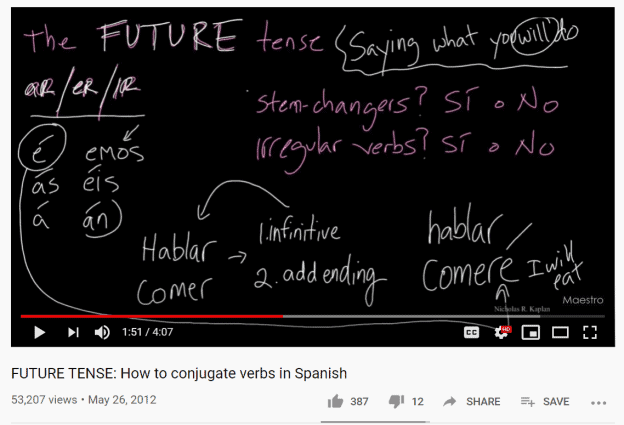
Many of the videos come from this Youtube channel and can be accessed for free.
They make for a more engaging way to interact with the material and the way that they’re integrated with the Lengalia curriculum works well.
Practice
Alright, so after you’ve been introduced to the lesson concept and an explanation of what’s going on, you get to practice. Let’s look at some of the practice exercises that come with a grammar lesson.
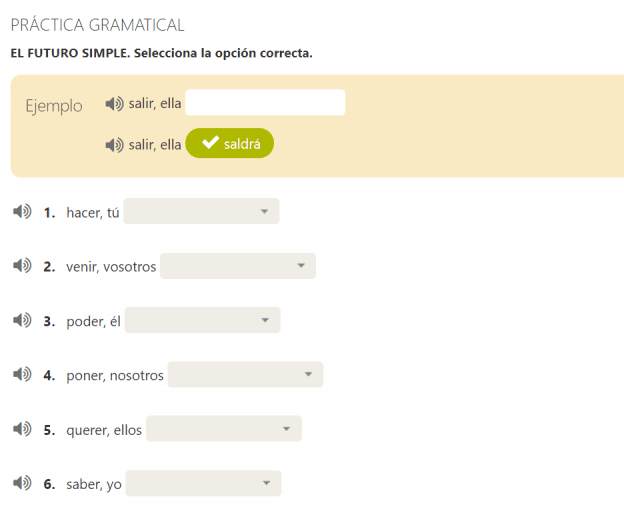
The practice is basic at the start. Simply conjugate the verb correctly by choosing from a drop-down list.
There are a ton of practice exercises in a grammar lesson. As you progress, things will become a bit more complex. You’ll move on from simply conjugating to choosing the correct verb/form based on the context of a reading or dialogue.
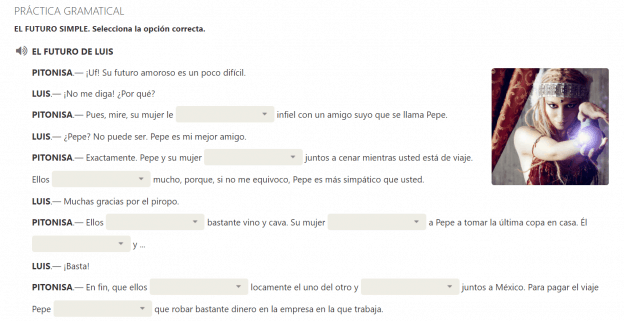
The scaffolding of the practice activities is great. The way they build on each other makes sense and feels thorough. For this particular grammar lesson, there are 21 pages of practice activities! Completing all of them in one sitting is a serious endeavor.
There are also a lot of practice opportunities for lower-level material, but it’s much more basic and doesn’t vary as much.

While the practice activities build on each other nicely and there is some variety, they do get pretty monotonous after a while.
Vocabulary
This section of a lesson is where you’ll get practice opportunities that should help you build your vocabulary.
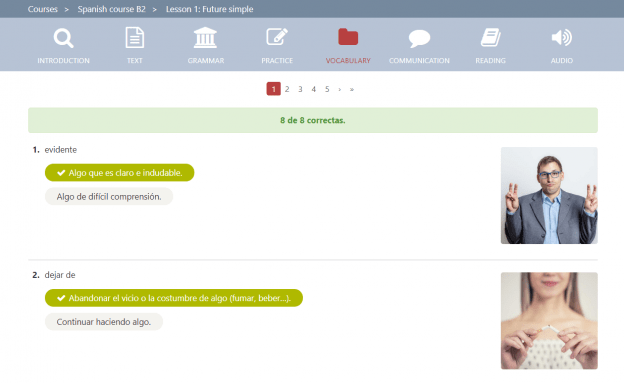
In the above example, you simply have to select the correct definition for each word or phrase. The pictures help.
Below is an example of some vocabulary practice at the A0 level.

These practice exercises are very similar in type to the grammar activities and feel like a written test.
Some people might not like the aesthetic here. It’s not very interactive and isn’t especially engaging. The pages and pages of multiple-choice questions are repetitive and could easily bore people.
Communication
The communication exercises are similar to all the others in that they’re multiple-choice, but they try to tackle communicative themes.
At the B2 level, this means practicing things like tone and implicit meaning.

These types of questions are good practice for advanced learners that already have a lot of vocabulary. Get a wrong answer, though, and there are no explanations to help out.
This type of material is obviously too advanced for beginning learners; here’s what the communication exercises look like at the A0 level.
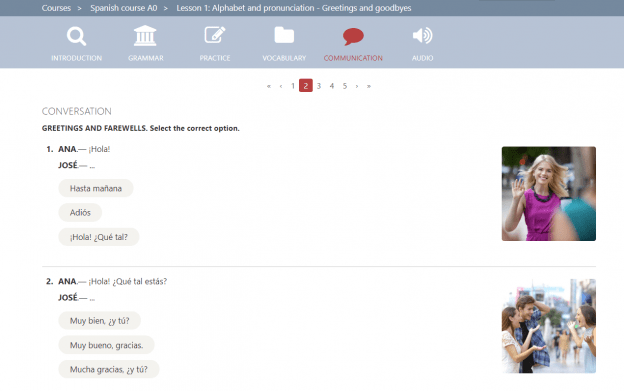
Greetings and farewells; that’s good beginner material. I’m not a big fan of resources that teach you by throwing questions at you and having you guess until you start to get it right. Fortunately, Lengalia offers explanations and instruction for this kind of thing. If you get an answer wrong, you’ll be able to see a detailed explanation that describes the correct answer.
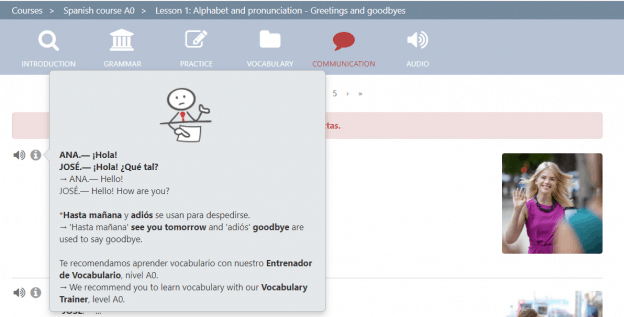
You can also see in this explanation that they recommend learning new vocabulary with the Vocabulary Trainer. We’ll check this out in the Resources section below.
Reading
This is another lesson section that isn’t part of the lower-level courses. It’s a piece of reading that uses the target language from the lesson with comprehension questions.
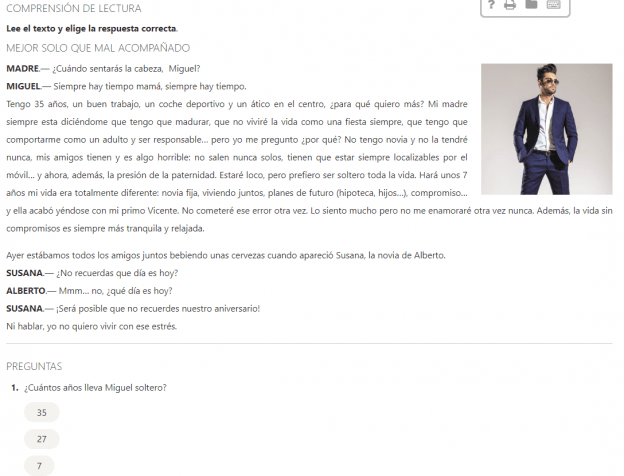
I had already seen some of the sentences in the text from the grammar explanations in the grammar section of the lesson. The fact that the material comes full circle like this is great and makes for a thorough and complete-feeling learning experience.
Audio
This part of the lesson is great for getting a bunch of listening practice. At intermediate levels and above, you’ll listen to a piece of audio and then answer comprehension questions about it.
There are sometimes up to six or seven questions on one piece of audio, but there are also plenty of recordings to listen to and practice. There’s even a video component to some of the lessons in this section.

This example comes from the Qué Mañana! Youtube channel, an Argentinian cooking/variety show. After watching the video, you can answer some questions to check your comprehension in Lengalia.
The audio material in the beginner courses is more basic, but it’s still a good way to get listening practice.

There are both fill-in-the-gap exercises and those that require you to listen to a piece of dialogue before selecting the correct response.
I think the listening practice in the Audio section is pretty good for both beginners and more advanced students, and the use of video with comprehension questions is something I really like.
Thankfully, the audio quality is good; Lengalia doesn’t rely on text-to-speech technology like some other resources.
Tutor
A subscription to Lengalia comes with access to online tutors, but I found this misleading. Instead of a resource like Baselang, where a tutor will go through online classes with you in a structured manner, the Lengalia tutors seem to be something more akin to customer support staff.

Having personable and reliable customer service is a big bonus, but it isn’t the same as having a one-on-one teacher to offer feedback and instruction.
Podcasts
The podcasts in Lengalia feel more like extended listening practice exercises than podcasts, but they are a useful way to get listening practice as well as get some insights into Spanish life and culture.
The podcasts consist of a dialogue (with transcript), a glossary of the most relevant words and phrases from the lesson, some multiple-choice exercises, and a video with comprehension questions.
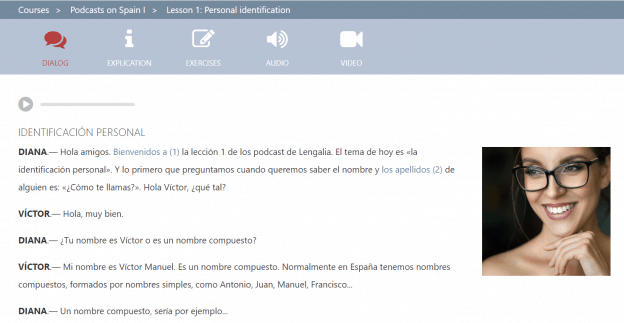
The dialogues are pretty good and include some good information for those interested in Spanish culture. Making connections with the culture can really deepen your understanding of the language; it’s something I find very useful.
After the dialogue comes the “Explication,” or, glossary of relevant language from the dialogue. You can practice these pre-selected phrases with the Lengalia’s Vocabulary Trainer.
The Exercises and Audio sections are both opportunities for practice via multiple-choice questions. They use information and language constructions from the podcast material, and there’s a lot of practice exercises. In this podcast, there are 10 pages of reading exercises and 16 audio clips with questions. It takes a while to get through the material and the practice is thorough.
On top of all this, there’s a video that comes with each podcast lesson.
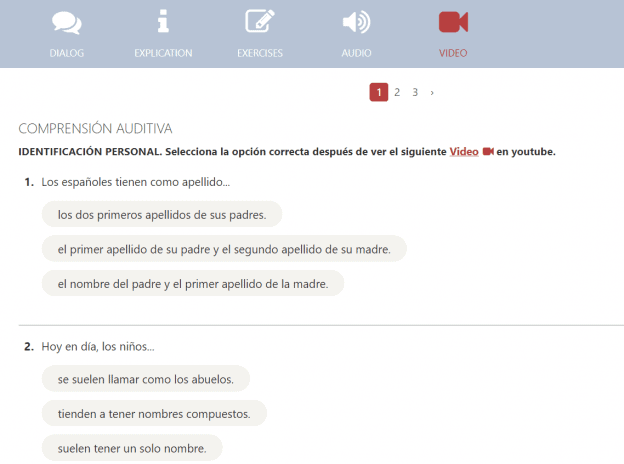
The video is related to the content covered in the podcast but is different. The videos are sometimes a little bit cheesy, but the quality is good enough and the comprehension questions make it a valuable practice activity.
CEFR Certificates
These certificates are useful to people that are looking for employment or admission to a university in a Spanish-speaking country. They are internationally recognized and represent your Spanish proficiency.

If your aim is to acquire a certificate, Lengalia could be a good option. It isn’t as prestigious or widely recognized as the DELE or SIELE, but it is less expensive. If you need a CEFR certificate, be sure to do some research to find out if you need a specific one.
Extra Features and Resources
In addition to all of the content on Lengalia, it offers a handful of nifty features that are supposed to enhance the learning experience. Some of these work really well, and some of them are non-existent.
Automatic Translation Tool
This is one of the features that actually works well and streamlines the learning process. It’s an automatic translation tool that’s activated any time you highlight a word or group of words.
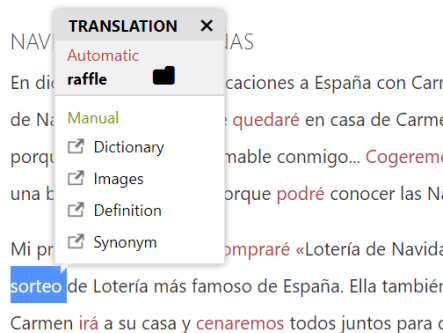
It took me a little practice to get used to it — I tend to highlight text as I read and was constantly triggering the translation tool without meaning to. This used to be an unconscious habit, and now it’s something I’m painfully aware of!
Bizarre reading habits aside, this tool is super helpful and streamlined. The translations are of high quality and make reading difficult texts much easier. The fact that there isn’t a translation of the entire text readily available means you won’t end up relying too heavily on the translation, either.
Verb Conjugator/Vocabulary Trainer
This is a very basic feature that’s built for focused conjugation practice or vocabulary practice. For verb practice, simply select a verb tense you’d like to practice and get ready to flip through flashcards.
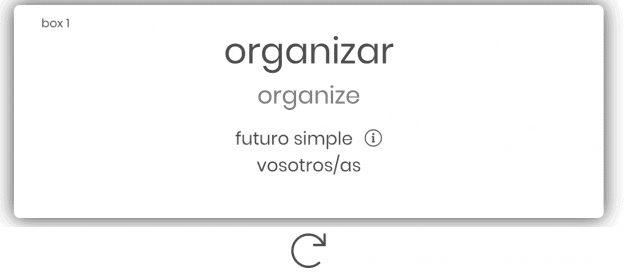
You’ll see the infinitive tense, the English translation, and the pronoun you’ve got to conjugate for. Answer the question in your head and then “flip the card over” to see the answer.
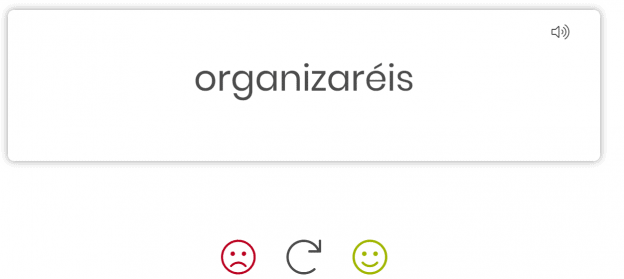
You’ll then see the correct answer as well as hear a recording of it. Finally, self-assess by choosing a happy or sad face and move to the next.
To be honest, this activity is pretty boring. The stack of cards for the future simple includes 40 words. It takes a while to finish and is less than exciting. At any time, you can finish your session and see your score. You can also elect to practice, regular, irregular, or all verbs.
The Vocabulary Trainer functions in exactly the same way, except your task is to translate words and phrases instead of conjugate verbs.
Virtual Teacher
This sounds like more than it is.

They’ve really just tried to personify some of the basic functions of the program for some reason.
Tandem
There used to be a language exchange aspect of Lengalia, and you can still see it advertised here and there on older promotional material on the internet, but it’s no longer available.
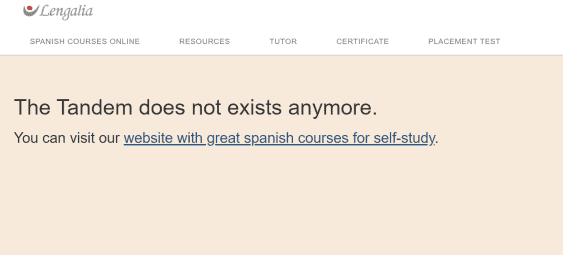
The typo and awkward phrasing in the bolded sentence above is something that happens semi-frequently in the English text on the site. It never really gets in the way of understanding, but it doesn’t put me at ease and kept me from fully trusting the resource.
I’m still not sure whether or not Lengalia used to be affiliated with this Tandem, but it’s worth trying out for those interested in language exchange.
Pricing
Lengalia offers a free two-day trial for potential subscribers, and it includes all of the material that’s available for paying users.

For those that want continued access to the material and the benefit of having their progress tracked, subscriptions are available.
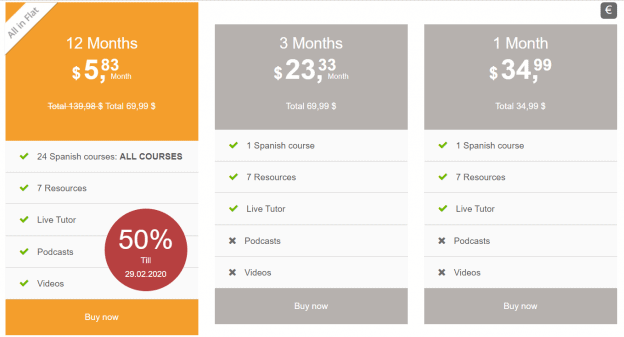
This isn’t an inexpensive resource. It’s also got an interesting pricing model; if you want access to all of the Lengalia material, you’ll need to purchase a year-long subscription. Interestingly, the 50% discount shown on the annual subscription seems to be never expire as the end date simply reset at the end of the month.
Your other options both involve purchasing access to one course, without video or podcast access, for one or three months.
Alternatives
As far as resources for learning Spanish go, it’s hard to beat Baselang. It’s more expensive than Lengalia, but it’s got the added advantage of unlimited access to one-on-one lessons with Venezuelan teachers. This is a huge value to anyone interested in getting the most comprehensive Spanish education possible. It’s also got curriculums for all levels and for those preparing for the DELE.
For beginners and intermediate learners interested in a less expensive but still high-quality resource, News in Slow Spanish delivers. It’s got plenty of listening, reading, and grammar exercises to help you quickly improve your Spanish, and it’s more engaging and fun to use than Lengalia.
If the Lengalia podcast feature is what you’re most interested in, be sure to consider some of these. We’ve tried out a ton of Spanish Podcasts, and the best one for you will depend on your level of Spanish.
The addition of Youtube videos to the Lengalia material is a great touch. There is a lot of free quality content on Youtube for free, and it’s worth checking out, especially as supplementary study material. Here are our favorites.
As always, our favorite resources vary by language. Spanish is quite a popular language to learn, and so the options are almost limitless. To find one that will work best for you, read about the ones we recommend the most here.
Final Thoughts
My experience with Lengalia was kind of a rollercoaster. My first impression wasn’t great, mostly because of all of the stock photos on the website and the rather dry web design. Then, I was really impressed by the free placement test. Although it only tests receptive skills, it’s very thorough and able to cover some advanced material.
This continued to be something I liked about Lengalia — it’s thorough. The lessons are structured in a logical way and offer plenty of opportunities for practice, and there are several different types of practice.
My appreciation for how thorough it can be is tempered by the fact that there are some mistakes in the material and that practice can get pretty monotonous.
This resource might be a good fit for someone that needs to get a CEFR certificate, but I think there are better, and less expensive, ways to learn Spanish.
All considered, there are far worse resources than Lengalia. Its strong points include heaps of listening and reading practice, decent grammar explanations, and well-structured lessons at all levels. I think trying it out for free is well worth your time.

